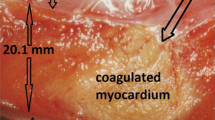Abstract
Purpose
Despite the wide use of cryoenergy, there is a paucity of data regarding the impact of certain ablation parameters on lesion size. Specifically, this study sought to evaluate the impact of catheter type, ablation time, heat load, and tip orientation on lesion dimensions using a porcine thigh model with focal cryoablation catheters.
Methods
In 6 pigs, 251 lesions were created on thigh muscle with parameter permutations to compare the acute impact of catheter type (electrode tip sizes 4, 6, and 8 mm), ablation time (2, 2 × 2, 3, 4, and 2 × 4 min), heat load (1 and 2 L/min), and tip orientation (perpendicular or parallel) on lesion dimensions (length, depth, and cross-sectional area) immediately post-ablation. As a sub-study to evaluate the importance of tissue contact during the cryoablation procedure, a 1-min freeze was performed without tissue contact until an ice ball formed, followed by an additional 2–3 min freeze.
Results
The linear regression model revealed that catheter type (p < 0.0001) and the interaction between catheter orientation and catheter type (p = 0.027) were significantly associated with lesion cross-sectional area. Lesion length and depth, but not cross-sectional area, are significantly impacted by the catheter type (p < 0.0001; p = 0.003) and orientation (p < 0.0001; p < 0.0001), respectively. Compared to parallel catheter placement, lesions created with the perpendicular orientation were deeper using 4-mm (p = 0.136), 6-mm (p = 0.005), and 8-mm tip catheter (p = 0.004). Lesion creation with an ice ball significantly reduced lesion depth compared to lesions made without an ice ball (p < 0.05). In contrast, ablation time (p = 0.097) and heat load (p = 0.467) were not significantly associated with lesion size. Additionally, there was no statistical significant difference in lesion size between 2 × 2 and 4 min ablation times.
Conclusions
The present study demonstrated that lesion size was significantly impacted by catheter type and catheter tip orientation and that maintaining tissue contact prior to applying cryoenergy is essential.





Similar content being viewed by others
Abbreviations
- TTC:
-
2,3,5-Triphenyltetrazolium chloride
References
Baust JG, Gage AA. The molecular basis of cryosurgery. BJU Int. 2005;95(9):1187–91.
Avitall B, Kalinski A. Cryotherapy of cardiac arrhythmia: from basic science to the bedside. Heart Rhythm. 2015;12:2195–203.
Klein GJ, Harrison L, Ideker RF, Smith WM, Kasell J, Wallace AG, et al. Reaction of the myocardium to cryosurgery: electrophysiology and arrhythmogenic potential. Circulation. 1979;59(2):364–72.
Tse HF, Ripley KL, Lee KL, Siu CW, Van Vleet JF, Pelkey WL, et al. Effects of temporal application parameters on lesion dimensions during transvenous catheter cryoablation. J Cardiovasc Electrophysiol. 2005;16:201–4.
Pilcher TA, Saul JP, Hlavacek AM, Haemmerich D. Contrasting effects of convective flow on catheter ablation lesion size: cryo versus radiofrequency energy. Pacing & Clinical Electrophysiology. 2008;31(3):300–7.
Khairy P, Chauvet P, Lehmann J, Lambert J, Macle L, Tanguay JF, et al. Lower incidence of thrombus formation with cryoenergy versus radiofrequency catheter ablation. Circulation. 2003;107(15):2045–50.
Nakagawa H, Wittkampf FH, Yamanashi WS, Pitha JV, Imai S, Campbell B, et al. Inverse relationship between electrode size and lesion size during radiofrequency ablation with active electrode cooling. Circulation. 1998;98:458–65.
Haines DE, Strunk AR, Novichenok A, Kirchhof N, Stewart M. The biophysics of passive convective cooling during catheter ablation with gold versus platinum electrodes and multielectrode phased radiofrequency energy delivery. J Cardiovasc Electrophysiol. 2015;26:1257–61. https://doi.org/10.1111/jce.12752.
Wijffels MC, Van Oosterhout M, Boersma LV, Werneth R, Kunis C, Hu B, et al. Characterization of in vitro and in vivo lesions made by a novel multichannel ablation generator and a circumlinear decapolar ablation catheter. J Cardiovasc Electrophysiol. 2009;20:1142–8.
Tse HF, Liao S, Siu CW, Yuan L, Nicholls J, Leung G, et al. Determinants of lesion dimensions during transcatheter microwave ablation. Pacing Clin Electrophysiol. 2009;32:201–8.
Khairy P, Rivard L, Guerra PG, Tanguay JF, Mawad W, Roy D, et al. Morphometric ablation lesion characteristics comparing 4, 6, and 8 mm electrode-tip cryocatheters. J Cardiovasc Electrophysiol. 2008;19:1203–7.
Andrade JG, Dubuc M, Guerra PG, Landry E, Coulombe N, Leduc H, et al. Pulmonary vein isolation using a second-generation cryoballoon catheter: a randomized comparison of ablation duration and method of deflation. J Cardiovasc Electrophysiol. 2013;24:692–8.
Takami M, Lehmann HI, Misiri J, Parker KD, Sarmiento RI, Johnson SB, et al. The impact of freezing time and balloon size on the thermodynamics and isolation efficacy during pulmonary vein isolation using the 2nd generation cryoballoon. Circ Arrhythm Electrophysiol. 2015;8:836–45.
Handler M, Fischer G, Seger M, Kienast R, Hanser F, Baumgartner C. Simulation and evaluation of freeze-thaw cryoablation scenarios for the treatment of cardiac arrhythmias. Biomed Eng Online. 2015;14:12.
Kuck KH, Fürnkranz A. Cryoballoon ablation of atrial fibrillation. J Cardiovasc Electrophysiol. 2010;21:1427–31.
Funding
This work was financially supported through a Medtronic research grant.
Author information
Authors and Affiliations
Corresponding author
Ethics declarations
The pig specimens were housed and received humane care in accordance with the Guide for Care and Use of Laboratory Animals and the Animal Welfare Act as amended. The study protocol was reviewed and approved by the Medtronic PRL IACUC (Institutional Animal Care and Use Committee).
Conflict of interest
The authors declare that they have no conflict of interest.
Rights and permissions
About this article
Cite this article
Miyazaki, S., O’Connell, H. & Maus, B. Parameters associated with acute morphometric lesion dimensions created by cryocatheters. J Interv Card Electrophysiol 54, 109–118 (2019). https://doi.org/10.1007/s10840-018-0452-x
Received:
Accepted:
Published:
Issue Date:
DOI: https://doi.org/10.1007/s10840-018-0452-x




